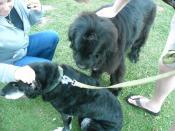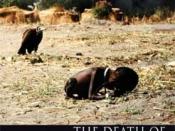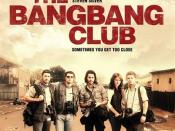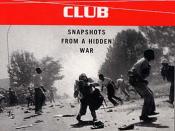Nowadays, photojournalism plays an essential role in the media. Almost every article has at least one picture on the side, which makes a pertinent job in attracting readersÃÂ attention. The photos depicting victims of tragic events are preferred by the media, since they make a good lead. Even though some readers might feel offended by photos presenting shocking events, many Pulitzer Price winning photos have violence and poverty as topics. They horrify people, they are shocking, but controversy makes them popular and thus, they serve their cause: to point out that our society is not perfect. ÃÂIt is as if viewers want to see violent pictures, but through gaps in the fingers in front of their face.ÃÂ1Everyone has a word to say about controversial pictures. But not many think of what the photographer had to undergo to take that picture. Few people perceive photojournalism as a risky job.
Four American photojournalists experienced great risks to cover the South African war during 1990-1994.
Greg Marinovich, Joao Silva, Kevin Carter and Ken Oosterbroek formed ÃÂThe Bang-Bang Club,ÃÂ nickname a South African magazine gave them for being fearless and also reckless in taking their job to extremes. During the struggle to end the apartheid, the four white photographers had their privileges -ÃÂrelative protection afforded by their skin,ÃÂ2 but they had to pay extreme psychological costs, and two of them even with their lives.
The risk being so high and the pictures controversial, a couple of moral questions came up: How much should a photographer risk in taking a photo? And when should he stop being a simple photographer and get involved into what is happening around?ÃÂThese were the moral dilemmas the four members of the Bang-Bang Club grappled with on a daily basis.ÃÂ3 They were all rewarded with honors as photojournalists for the risky job they had done. Marinovich won the Pulitzer for Spot News in 1990, with his picture ÃÂHostel Wars,ÃÂ depicting a burning man as a young boy runs away.
Three years later, Carter won the Pulitzer Price for Feature Photography for one of his photos of a starving girl stalked by a vulture. The image of the emaciated child making her way to a feeding center became a symbol of many humanitarian groups in their fundraising campaigns. It served a good cause, so it was worth taking it, some might say. But others raised some moral issues concerning the duty of a photojournalist ÃÂ when does it end, when should the journalist intervene and help the people he or she is taking pictures of? Carter could have chased the vulture away, and helped the girl to get to the humanitarian center, which was only one hundred meters away.4 Had he done this, the event would not have reached so many people. The picture would not have had the same effect if it was of a starving girl brought to a relief station. Also, the image would have reflected a distorted reality: the photographer had intervened in the picture, before taking it; it is the same as if setting a stage. Another issue brought up by this picture was whether Carter helped the girl after shooting the photo. He said in a later interview that he scared off the bird, but did not take the girl to the center. This event would obsess him for the rest of his life. But the odds for the girl to still be alive are low even if she reached the center. And if she is still alive, what is the quality of her life? Why judging the photographer for shooting a picture of a starving child among other thousands?Carter said that after taking the picture, he sat under a tree ÃÂsmoking cigarettes and crying.ÃÂ5Greg Marinovich and Joao Silva, the only ones alive after the South African struggle, published a book called The Bang Bang Club, which includes some photos taken at that time and also a lot of information about their lives in South Africa. It is ÃÂa memoir cum historyÃÂ4 that helps the readers see past the photos, and get to know some of the crimes and injustices during the anti-apartheid struggle. But the book also served as a therapy for the soul of the authors, as it is very difficult to go on with your life after such terrible experiences.
Some striking excerpts of the book are the ones referring to the death of Ken Oosterbroek, during intensive firefighting outside Johannesburg. The scene is very detailed, and pulls the reader in. Both Oosterbroek and Marinovich were shot, but it was fatal for Oosterbroek. While some soldiers were carrying his dead body, Silva was torn between taking pictures of his dead friend, and helping the others carry the body to a safer place. The moral question to stop being a photographer and help carrying his dead friend came up to his mind. When do you have to stop shooting? Was it more important to take photos of what was going on or to help putting the dead body aside? He chose to shoot pictures, and ÃÂwas annoyed that Ken's hair was in his face, ruining the picture.ÃÂ6 He thought that his friend would have wanted him to do that: "Ken will want to see these later."6 Taking pictures of those moments was far more important, so people would see how things took place.
Oosterbroek was not the only victim of the Bang-Bang Club. Months after his death, Kevin Carter killed himself. He was very frustrated because of this whole experience, of all the guilty feelings for not being able to help the people, of losing a good friendÃÂ All four photojournalists had to pay a great price for going through such striking experiences. They all faced guilt, the acute feeling of being unable to save the lives of their subjects. Sometimes they chose not to even try helping them; the feeling of uselessness and despair prevailed. Some journalists would often appeal to alcohol and drugs, to cope with these daily dilemmas.
But the pictures they have offered to the world are highly valuable, as they made people understand which the conditions in South Africa were at that time. Even though some of them might seem offending to some people, these photos helped many relief organizations in fundraising.
The Bang-Bang Club were some of the best photographers in South Africa during a time when the whole world had to know what was going on in that country. They took exclusive pictures that changed peopleÃÂs attitudes and helped them understand the world better. They chose to answer to the moral questions brought up all along their stay in South Africa by continuing to take pictures no matter what. It was an extreme experience, but their passion for photography overcame the hardships they encountered during the four years of anti-apartheid war.
Works Cited:1. Lester, Paul Martin. ÃÂPhotojournalism Ethics Timeless Issues.ÃÂ California State University, Fullerton. Updated: 1995. Accessed: November 2005. 2. Wylie, Diana. The Bang-Bang Club: Snapshots from a Hidden War by Greg Marinovich; Joao Silva. Article published on Updated: 2005. Accessed: November 2005. < http://links.jstor.org/sici?sici=0361-7882%282001%2934%3A1%3C143%3ATBCSFA%3E2.0.CO%3B2-E>3. The Digital Filmmaker. ÃÂThe Bang Bang Club.ÃÂ Updated: November 2005. Accessed: November 2005. 4. Catsam, Derek Charles. ÃÂThe Bang Bang Club: Snapshots From a Hidden War.ÃÂ African Studies Quarterly. Volume 7, Issue 1. Updated: Spring 2003. Accessed: November 2005. 5. The New York Times, cited on the Obituary: Kevin Carter, 1960-1994. Updated: June 2005. Accessed: November 2005. 6. Marinovich, Greg & Silva, Joao. The Bang-Bang Club: Snapshots from a Hidden War. New York: Basic Books, 2000.





